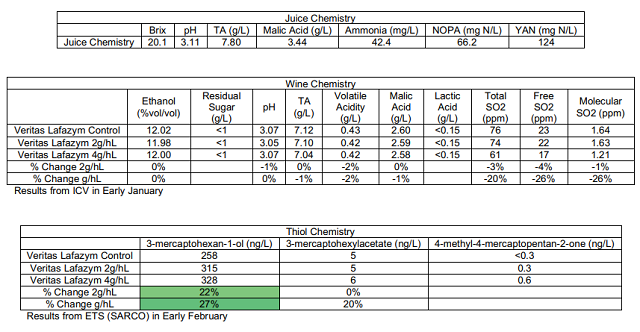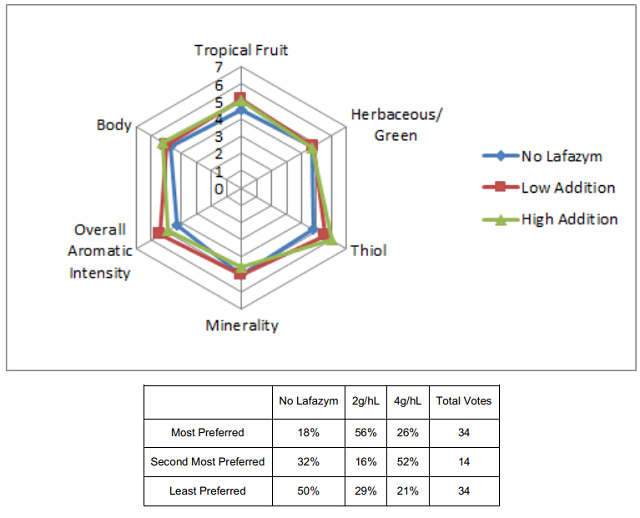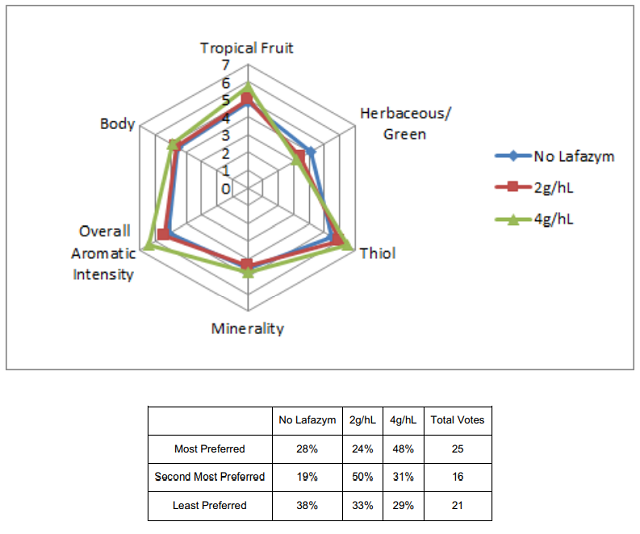Sauvignon Blanc Production with Lafazym Arom (2017)
Emily Pelton
Veritas Vineyards and Winery
Summary and Introduction
This study examines the use of Lafazym Arom (Laffort) (pectinase and β-glucosidase) additions on the varietal character of Sauvignon blanc wines. Many volatile aroma compounds are glycosylated, resulting in very high solubility and low volatility. Thus, these compounds must be enzymatically cleaved to remove the glucose moiety in order for these aromatic compounds to be sensed. Lafazym Arom is an enzyme which may be able to impact the sensorial attributes of certain grape varieties, particularly terpenic varieties. Sauvignon blanc was harvested, destemmed, and cold soaked for 20 hours, after which grapes were pressed and settled with CinnFree for one day. Juice was racked into stainless steel barrels for fermentation and inoculated with Vin-2000. Different barrels received different rates of addition of Lafazym Arom after fermentation: 1) no Lafazym, 2) 2/ghL (low rate) Lafazym, and 3) 4g/hL (high rate) Lafazym. Barrels were then topped with sulfur dioxide. All other treatments between wines were equal. No differences in wine chemistry are apparent between treatments. Enzyme addition increased 3-mercaptohexanol, perhaps with diminishing returns at larger doses. Overall, wines produced with Lafazym Arom tended to have higher Overall Aromatic Intensity and Thiol Character. Tropical Fruit character also was generally increased with Lafazym Arom. Wines made with Lafazym Arom tended to be more preferred, although differences were present with regard to the rate of Lafazym addition. These results suggest that Lafazym Arom can have a large impact on the aromatic qualities of Sauvignon blanc.
Results and Discussion
No differences in wine chemistry are apparent between treatments. Enzyme addition increased 3-mercaptohexanol, perhaps with diminishing returns at larger doses.

For the descriptive analysis on January 31, there was a strong trend for no Lafazym addition to have less Thiol character, and for Overall Aromatic Intensity higher with 4g/hL and highest with 2g/hL addition (LSD=0.61 and 0.37, respectively). There was a slight tendency for Tropical Fruit qualities to be higher with Lafazym addition as well. The most preferred wine was that made with 2g/hL Lafazyme, the second most preferred wine was 4g/hL Lafazym, and the least preferred was no addition.

For the descriptive analysis on February 7, there was a strong tendency for the 4g/hL wine to have higher Thiol character than the No Lafazym treatment (LSD=0.62). There was a slight tendency for No Lafazym to have higher Herbaceous/Green character, and less Overall Aromatic Intensity. 2g/hL addition did not impact the wine as much compared to the Control. In general, the 4g/hL treatment was most preferred, followed by the 2g/hL treatment. The least preferred treatment had No Lafazym.

Overall, wines produced with Lafazym Arom tended to have higher Overall Aromatic Intensity and Thiol Character. Tropical Fruit character also was generally increased with Lafazym Arom. Wines made with Lafazym Arom tended to be more preferred, although differences were present with regard to the rate of Lafazym addition. These results suggest that Lafazym Arom can have a large impact on the aromatic qualities of Sauvignon blanc.
Methods
Sauvignon Blanc was harvested, destemmed and cold soaked for 20 hours at 45°F with a 40ppm sulfur dioxide addition. Then the grapes were pressed off using a Champagne cycle and a press fraction was kept separate. The juice was settled with 1.6 mL/hL of Cinn Free for 24 hours and then racked off of juice lees to stainless steel barrels for fermentation. The juice was inoculated with 20g/hL of Vin-2000 rehydrated with 10g/hL Fermo Plus Energy Glu. Yeast nutrient Fermo Plus DAP free was used to adjust the Nitrogen level to 200mg/L as Nitrogen. Lafazyme Arom was added post fermentation without racking to the stainless steel barrels at low rate (2g/hL) and high rate (4g/hL), with the control having no addition of Lafazyme Arom. The barrels were topped off and 25 ppm of sulfur dioxide was added.
These wines were tasted on January 31 and February 7, 2018. In order to balance the data set to perform statistical analysis for descriptive analysis on the January 31 tasting, any judge who had not fully completed the descriptive analysis ratings were removed. In order to then make the number of judges between groups equivalent, one judge from group 3 was transferred to group 2, and two judges from groups 1 were eliminated. This resulted in a final data set of 3 groups, each with 10 judges (considered as replications within groups, and groups were considered as assessors). Data was analyzed using Panel Check V1.4.2. Because this is not a truly statistical set-up, any results which are found to be statistically significant (p<0.05) will be denoted as a “strong trend” or a “strong tendency,” as opposed to general trends or tendencies. The statistical significance here will ignore any other significant effects or interactions which may confound the results (such as a statistically significant interaction of Judge x Wine confounding a significant result from Wine alone). The descriptors used in this study were Tropical Fruit, Herbaceous/Green, Thiol (grapefruit, boxwood, passionfruit, guava, etc), Minerality, Overall Aromatic Intensity, and Body.
The same procedures for data analysis were used on the February 7 tasting. For the descriptive analysis in this tasting, one judge was eliminated from group 1 so that each group had 7 judges, for a total of 21 judges.
